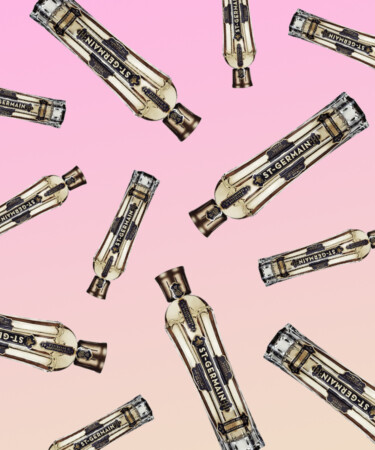Launched in 2007 by third-generation distiller Robert J. Cooper, St-Germain Elderflower Liqueur kickstarted an elderflower craze that would span the next decade and a half and revived a sleepy liqueur industry. Now owned by Bacardi Limited, St-Germain is one of the most commonly used liqueurs in the world and even garnered a host of media attention after Prince Harry and Meghan Markle announced their lemon elderflower wedding cake. Beloved by bartenders everywhere, St-Germain’s delicate floral notes and natural flavors of pear and honeysuckle make the liqueur a savvy addition to a number of cocktails as well as a great stand-alone aperitif in simple spritzes. Now that you know the basics, here are eight more things you should know about St-Germain.
Every elderflower used to produce St-Germain is handpicked.
Each bottle of St-Germain contains up to 1,000 elderflower blossoms, all of which are handpicked annually. Each year when the flowers blossom in late May, farmers spend roughly three to four weeks gathering the blooms that will be used to produce the liqueur. The flowers are all picked in the mornings, when temperatures are at their lowest. This practice allows producers to ensure that the elderflower blossoms are only just beginning to open, meaning the aromas and flavors of the buds will be at their most prominent. In fact, St-Germain’s unique coloring does not come from any artificial additives, but instead is a result of the pollen from each bud blending with the liqueur’s liquid components. Due to the delicate nature of handpicking and the finite yield harvested, limited batches of St-Germain are produced every year.
The liqueur is named after a creative epicenter.
For centuries, Paris’s Saint-Germain-des-Prés neighborhood has been widely recognized as one of the world’s most prominent meeting places for artistic creation. The area, which contains the iconic Luxembourg Gardens and a multitude of art galleries, was once home to creative greats like cubist painter Pablo Picasso, poet Charles Baudelaire, and novelist Ernest Hemingway. St-Germain, which was inspired by the neighborhood’s essence, took on the name in hopes of encapsulating the same energy. The Art Deco-esque appearance of the bottle also serves as a nod to the bustling Parisian quarter — the brand hopes to provide an experience reminiscent of the Roaring Twenties, when Saint-Germain-des-Prés was at its creative peak.
For St-Germain, liqueur is thicker than water.
St-Germain was created by Robert Cooper, the son of Chambord inventor Norton “Sky” Cooper. The Cooper family as a whole has been heavily involved in the spirits industry since the early 1900s when Maurice J. Cooper, a merchant of imported food and beverage, partnered with the Charles Jacquin et Cie cordial business. The partnership, which was finalized in 1933, helped transform Jacquin’s into one of the world’s leading producers of liqueurs and cordials. In 2006, father and son duo Norton and Robert created the Cooper Spirits Company, which today houses labels like St-Germain, Crème Yvette, and many more under its umbrella.
St-Germain was inspired by a cocktail.
In the early 2000s, Robert Cooper was visiting a London bar where he ordered a cocktail that featured elderflower syrup as a sweetening agent. Though he had never viewed elderflower as a cocktail ingredient, the floral concoction changed his perspective. Already connected with a vast network of liquor and liqueur producers due to his familial relationships, Cooper decided to explore the possibility of creating his own elderflower liqueur.
St-Germain inspired Robert to go it alone.
When Robert returned from London and approached his father about creating an elderflower liqueur, his father was immediately skeptical. As such, he was hesitant to allow Robert to use their company’s resources to produce the spirit. When Cooper responded by leaving the family business behind, his father allegedly told him, “I’ll hire you back in a year when you fail.” As his luck would have it, he did not fail. Instead, a year after its release, St-Germain was already a staple on bartender’s back bars.
Cooper credits St-Germain’s success to the cocktail bar renaissance of the late ‘00s.
At the same time St-Germain Elderflower Liqueur was first hitting markets, cocktails and cocktail bars were undergoing a massive renaissance in major cities like New York. Two such cutting-edge cocktail bars — PDT and Death & Co. — had just opened, and bartenders at each were itching to experiment with new ingredients. This gave Cooper an “in” to introduce mixologists to St-Germain, which was instantly a hit. “It was lucky,” Cooper told The New York Times. “They wanted something different they could work with that had integrity.” Thus, Cooper credits the two bars with skyrocketing the liqueur’s success.
It’s been nicknamed the ‘bartender’s ketchup.’
St-Germain has grown to become one of the most valuable bottles in a bartender’s arsenal. In addition to being a great aperitif to throw in a spritz, St-Germain is considered to be a great modifying liqueur, altering the flavor profile of the liquor it is added to. It pairs well with almost every spirit, making it incredibly versatile behind the bar. Furthermore, St-Germain’s multitude of complex flavors allows for mixologists and novices alike to experiment with it, leading to its nickname, “the bartender’s ketchup” or “the ketchup of liqueurs.”
St-Germain wasn’t Cooper’s only creation.
Inspired by his floral-scented success, Robert Cooper was keen to revive previously popular brands from hibernation. Crème Yvette’s production halted in 1969 but relaunched to the liqueur market in 2010. He also reintroduced Hochstadter’s Slow & Low to the whiskey market in 2010. Robert Cooper was also a master of predicting trends and recognized an emerging excitement for rye whiskey. Anticipating high sales, Cooper purchased a number of barrels of Canadian rye and aged them for 13 years before releasing Lock Stock & Barrel in 2013.
